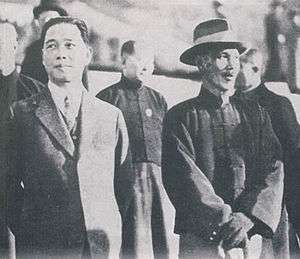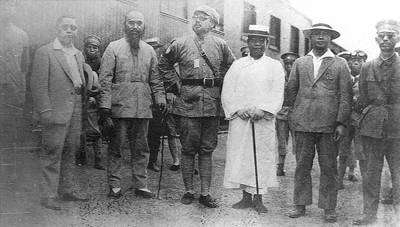Nanjing–Wuhan split

The Nanjing–Wuhan Split was a military and political standoff between the Kuomintang factions led by Wang Jingwei in Wuhan and by Chiang Kai-shek in Nanjing.
Events leading to the split
By the end of 1926, the Nationalist Army had conquered Wuhan, the power center of Zhili Clique warlord Wu Peifu, during the military campaign to reunify China. In order to consolidate the conquest, it was in the interest of the Nationalists to relocate from Canton to Wuhan. The Generalissimo Chiang Kai-shek initially invited the government to move to Wuhan but later demurred and tried to keep the members of the central committees in Nanchang where his headquarters were located[1]. By the time the government moved to Wuhan with its left-leaning leadership including Sun Fo, Xu Qian, T. V. Soong, the peasant and labor movement led by communists and leftists of Kuomintang was in full swing in Hunan and Hubei. It was during this period that Mao Zedong prepared his Report on an Investigation of the Peasant Movement in Hunan. In January of 1927, violent protests broke out in the British Concession of Hankou, resulting in its evacuation by the British and handover to the Chinese.
Under such an atmosphere the leftists expanded control over the Kuomintang government in the Third Plenary Session of the Second Central Committee of Kuomintang. The party congress elected a majority of communists and leftists into the central committees, and increased the Soviet grasp over the party at the expense of Chiang Kai-shek.[2][3] At the same time, Chiang was arresting communists as he advanced downstream the Yangtze River. It was widely suspected that the Communist Party of China and Soviet advisors in the Wuhan Nationalist Government used anti-imperialist and anti-foreign sentiments to instigate violent confrontations with foreign militaries in the Nanking incident to strengthen the communists and damage the right-wing faction of the Kuomintang.[4][5][6][7]
Joseph Stalin tried to persuade the small Communist Party of China to merge with the Kuomintang to bring about a bourgeois revolution before attempting to bring about a Soviet-style working class revolution.[8] Stalin funded the KMT during the Northern expedition.[9] Stalin said that Chiang was the only one capable of defeating the imperialists, and that his forces were to be squeezed for all usefulness like a lemon before being discarded.[10]
It was under these circumstances that a divergence between the KMT and CPC appeared. KMT right wing figures like Chiang Kai-shek pushed for the 'complete clearance of the Communist party'. Meanwhile, KMT left wing, CPC and the Communist International were alarmed and decided to support the leftist leader Wang Jingwei who previously had been exiled abroad.[11]
Chiang got into contact with members of the Western Hills Group, an anticommunist faction based in Shanghai, including Wu Zhihui, who together with Li Zongren and Bai Chongxi of the Guangxi Clique supported the purge of communists. Following Beijing government's raid on the Soviet embassy, the purge in Shanghai took place on April 12.
Open schism
On April 1, Wang Jingwei returned to Shanghai from abroad and promised to Chiang to facilitate a compromise with Wuhan, but a party-wide schism ensued. Chiang and the anticommunist Hu Hanmin formed a separate government in Nanjing, which was militarily backed by the Guangxi Clique, and Wuhan, backed by Tang Shengzhi and Zhang Fakui, excommunicated Chiang. Despite a military stand-off, conflicts were averted for the time being when the two sides agreed to continue the Northern Expedition on separate fronts.
Wang continued cooperation with the communists once he assumed leadership in Wuhan, but the patience of KMT leaders were wearing thin due to the economic disruption caused by incessant labor strikes and peasant movements.[1] Meanwhile, military leaders were turning against the reds because of communist massacres of landholders.[12] A coup took place in Changsha when the local army units purged the Kuomintang leftists and the communists though the rebels were expelled by troops loyal to Wuhan. Some other units also defected to the Nanjing government.
Tension mounting, the communist leadership debated whether to rein in the excesses of the peasant movement or to start an armed rebellion. The moderate option was discarded when the Secretary General Chen Duxiu stepped down on July 12. A combination of dissatisfaction with Comintern's agenda of subverting the Kuomintang[13] and the pressure from General Feng Yuxiang explains Wang's decision to purge the party of communists on July 15 in what is known as the "715 Incident", which triggered the August Nanchang Uprising.
Nanjing–Wuhan reconciliation

The end of the great party schism could be attributed to a political maneuver on Chiang's part. Following a military defeat in Xuzhou against the warlords Zhang Zongchang and Sun Chuanfang, Chiang resigned his command and the Guangxi Clique took over the Nanjing government. Li Zongren's forces then defeated Tang Shengzhi, the backer of Wuhan government. Wang fell from power but was soon reinstalled in Canton thanks to a coup by forces loyal to him.
With both Chiang and Wang out of the picture, the Nanjing government reunified different factions under a special committee. Chiang and Wang joined forces to counter the Guangxi Clique's influence. The special committee resigned and Chiang resumed his command, but Wang had to go because of complications from the communist Guangzhou Uprising.
References
- 1 2 Beifa Zhanzheng yu Beiyang Junfa de fumie, ed. Tianshi Yang, Vol. 5 of Zhonghua Minguo Shi, ed. Xin Li (Beijing: Zhonghua Book Company, 2011).
- ↑ 郭廷以:《中華民國史事日誌》,第二冊
- ↑ 李雲漢:《從容共到清黨》,下冊
- ↑ 日本外務省,日本外交文書,昭和2年,第一部第一卷,第527頁
- ↑ 郭廷以,中華民國史事日誌,台北,中央研究院近代史研究所,1985年
- ↑ 衛藤瀋吉,衛藤瀋吉著作集,第3卷,東方書店
- ↑ Keiji Furaya, Chiang Kai-Shek His Life and Times, translated by Chun-Ming Chang, (St.John’s Universtity 1981)p.189
- ↑ Joseph Stalin, "The Prospects of Revolution in China" a speech to the Chinese Commission of the Executive Committee of the Communist International on 30 November 1926" contained in J. Stalin on Chinese Revolution (Suren Dutt Publishers: Calcutta, India, 1970), pp. 5–21.
- ↑ Peter Gue Zarrow (2005). China in war and revolution, 1895–1949. Volume 1 of Asia's transformations (illustrated ed.). Psychology Press. p. 233. ISBN 0-415-36447-7. Retrieved 1 January 2011.
- ↑ Walter Moss (2005). A history of Russia: Since 1855. Volume 2 of A History of Russia (2, illustrated ed.). Anthem Press. p. 282. ISBN 1-84331-034-1. Retrieved 1 January 2011.
- ↑ 《蔣介石三次下野秘录》,59页
- ↑ 李守中 (2010). 中國二百年:從馬戛爾尼訪華到鄧小平南巡 1793-1992. 遠流出版. pp. 321–322. ISBN 978-957-32-6620-4.
- ↑ 李雲漢著:《中國近代史》,台北:三民書局,1986年